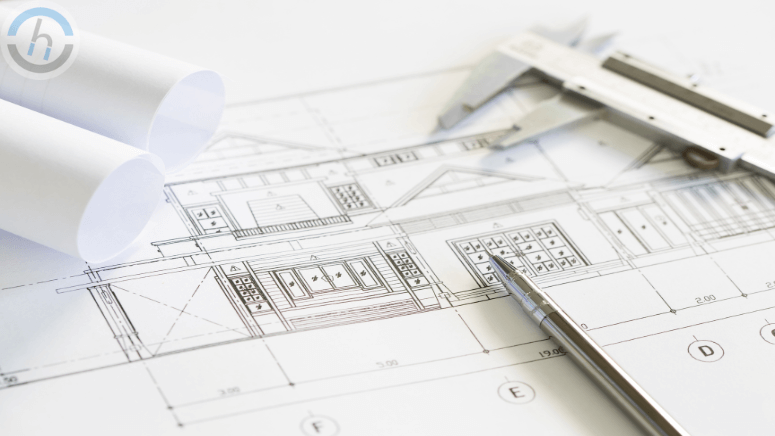Quick Summary: Let’s explore how building designing becomes easy with 46 types of different drawings. Here are all kinds of drawings.
The most crucial components for every building project are the drawings. Therefore, these different sorts of drawings are used for various purposes. In short, the sizes and sections of every building component are clearly shown in Construction drawings. The plans are examined, justified, amended, and eventually authorized for building.
Before beginning the project, a construction plan must be created. It provides a comprehensive synopsis of the framework. Numerous kinds of building drawings are now used for this purpose in light of this. These architectural drawing plans not only clearly illustrate technical aspects, but they are also necessary for project approval. They guarantee compliance with building codes and act as a standard for the construction process.
It is essential to create different styles of drawing before starting any work. It offers a thorough explanation of the structure. In light of this, many kinds of drawings are employed for this function nowadays. These drawings are necessary not only to provide the technical data in an understandable style but also to obtain project approval.
The construction plans serve as a guide for the building procedure and above all guarantee compliance with building codes. It might be suggested that these architectural construction drawings give architects a means of expressing their notions and ideas for the structure.
Building drawings come in a wide variety of formats, including architecture plan drawings, sketches, section drawings, line drawings, elevation drawings, foundation footing detail drawings, development drawings, CAD drawing solutions, and others. It is useful to understand the many kinds that engineers, CAD drawing companies, and building designers often employ since each design drawing construction for a structure is made to convey distinct design intentions and various guidelines for implementation.
Why Are Construction Drawings Needed In Building Design?
Building construction drawings convey all the specific information required for the job. AutoCAD construction drawing services make it easier for engineers, architects, builders, as well as project partners to communicate effectively. There are several uses for construction drawings, such as:
- Communicating design effectively
- Giving detailed instructions
- Increasing cooperation and coordination
- Assisting with code compliance
- Assistance with estimating expenses
- Precise planning and purchasing of materials
- Preparing construction documents
46 types of Drawings Used for Building Design
The 46 various types of architectural drawings, design build drawings, and certainly construction drawings used for building design are shown below:
Architectural Drawings
Before actual field construction starts, architectural design drawings provide technical details about a structure. Lines, projections, and a precise scale are used to make them. Check out the different types of architectural plans:
Site Plan
Aerial photographs of the construction location that include the main structure and other buildings are called site plans. The construction site drawing has various functions, in other words, it includes constructing architectural drawings for construction upgrades and estimating the size of construction projects.
Floor Plan
An elaborate variation of the room arrangement is seen in the floor plan. Regardless of whether they will be used in the development of commercial or non-commercial projects, floor plans are created.
Cross Section
The architect can distinguish between various architectural parts from a vertical view by using cross sections. Likewise, this 2D picture does a great job of giving a general overview of the visible and hidden parts of a building.
Elevation
These drawings include details regarding spaces, the height, and the exterior surface’s size and shape. So, having an aesthetic appreciation of the structure helps them get ready. In conclusion, they display the interior and external markings, including the door and window sizes.
Landscape
An aerial image of the full site of the building will be found in the landscaping plan. All designated areas for trees, parks, swimming pools, street lights, and other facilities are included. More frequently, landscape designs are used to depict the building’s outside splendor.
Finishing Drawing
Similarly, finishing drawings are a lesser component of a building project than detailed architectural structure drawings. As opposed to these designs, which heavily emphasize design features like floor patterns, wall paint colors, and plaster textures.
Reflected Ceiling Drawing
The ceiling perspective from the floor is represented by a reflected ceiling drawing. The visible columns’ designs, the ceiling’s lighting fittings, and the cornice’s decorative elements are all well depicted in these pictures.
Working Plan
Firstly, to assist the contractors in comprehending the breadth of the project, the designers provide working plans for them. The convenience of fabricating the building materials in accordance with the overall design is one of the advantages of such a scheme.
Section Drawings
Structures are depicted in section drawings in a sliced state. The heights and dimensions of the various components, as well as the sort of building materials to be utilized, are shown in these drawings.
General Note
General notes are comments or directions, and in addition, they offer specifications and other details about the designs. Therefore, these provide instructions and information to highlight the graphical features. Tolerances, dimensions, and other drawing elements are made clearer by general notes.
Excavation Drawing
To determine the breadth, depth, and length of the construction excavation, excavation drawings are required. In other words, it discusses the scope of the excavation, soil removal, and the excavation procedure.
As-Built Drawings
The As-built drawings services allow you to compare what has been constructed to the original plan. So, the contractors may need to alter the building pattern and design according to situational circumstances.
Line Plan
Lines are created to represent the various room layouts in single-line drawings that show the room structure. Room sizes are depicted in single-line drawings in addition to precise labeling.
Shop Drawings
Shop drawing services are another type of construction manual that illustrates how an item must be assembled, fitted, or produced. Therefore, these engineered drawings are often created by builders and contractors. These designs can also be created by manufacturers, fabricators, and suppliers.
Installation Drawings
Contractors can better visualize the installation of different systems thanks to installation drawings. Similarly, they act as visual cues to identify where MEP systems with connections are located. So, Installation drawings promote quicker execution, decrease mistakes, and minimize misinterpretations.
Location Drawings
The location plan encompasses a wide region. So, with the help of this kind of construction drawing, architects may evaluate the entire area where the structure will be built.
Record Drawings
Record drawings are produced by the architect and include any site modifications noted by the builder in the as-built drawings. So, In compliance with the owner-architect agreement, they are typically organized as a list of on-site adjustments performed for the owner.
Need construction drawings for your building design? Let’s get started!
Structural Drawings
A structural drawing is a layout, set of blueprints, or information illustrating how to build a structure or another building. Based on data given by engineers and the design team, these drawings are created. In conclusion, the primary emphasis of structural drawings is the load-carrying elements of a structure.
Engineering Drawing
Engineering drawings are used to show how certain construction components must be designed. As a result, these drawings correctly depict the geometrical characteristics of the construction components that builders and manufacturers use.
Column Layout
The collection of designs known as a column layout similarly, shows the layout, structure, and size of the floorwise columns across the entire building. This layout picture further illustrates the space within every column and aids builders in comprehending the layout of the entire building structure.
Plinth Beam Layout
Plinth beams are typically made of reinforced concrete and above all, built within the wall and the base. The placement, measurements, and sectional arrangement of the plinth beams are shown in the layout.
Lintel Beam Layout
A form of support framework that is constructed over the windows and doors is called a lintel beam. The precise placement, quantity, and size of the lintels are shown in lintel beam layouts.
Roof Beam and Shuttering Layout
Roof beams are load-carrying structures that hold up the floor and roofing above, as well as trusses, walls, joists, and various roof structures to reinforce the building structure. Shuttering, on the other hand, is the act of creating vertical support for damp concrete while waiting for it to attain the necessary strength. Because of this, drawings for roof beams and shuttering show the reinforcement, roof beam sections, and specific shuttering details.
Roof Slab Layout
Roof slabs are the structure’s highest point and are comprised of reinforced concrete slabs. The roof slab layout includes exact edge data for various surfaces as well as clear information regarding the roof faces and levels.
Block Plan
An illustrated block plan shows nearby structures with boundaries, roadways, and other elements, for instance. So, for town planning purposes, these designs provide a visual depiction of blocks inside cities. Therefore, they act as guides for designing and planning the construction process.
Framing Plans
Framing plans show the location, size, and quantity of the framework’s structural components. So, it is possible to create many frame drawings for an atypically shaped building structure’s walls, floors, and roofs.
Component Drawings
Component drawings offer comprehensive details on every single unit. Likewise, they provide details about things like component sizes, construction, limitations, and other things.
Concept Drawings
Concept drawings are sketches, frequently done by hand, utilized as an easy, rapid approach to analyzing design concepts. Similarly, they serve as a means of researching and disseminating design concepts and visual ideas; they aren’t meant to be exact or conclusive.
Assembly Drawings
To illustrate the link between two structural elements, Assembly drawings are frequently utilized in the construction industry. It shows how the many parts of this building work together. It has several designs and patterns kinds, including sectional, elevational, and 3D perspectives.
Design Drawings
Design drawings are utilized to assess design changes, explain development concepts to customers, and create designs.
Foundation Plan
For every building floor, foundation plans are prepared that present size, dimensions, form, levels, and other floor arrangements. They also show where various structural components should be placed in order to maintain strength, longevity, and load-bearing capability.
Expert AutoCAD construction drawing services for your project needs
Electrical and Plumbing Drawings
Electrical Drawings
An electrical drawing shows all of the electrical wiring, fittings, outlets, lights, fans, switches, and other parts in great detail. Therefore, these plans appear to be the electricians’ pillars of support in understanding the wiring placement on the floor.
Plumbing Drawings
Plumbing construction plans show the positions and marks of the plumbing components similarly to electrical drawings. This covers all plumbing-related elements, such as water lines, sanitary pipes, water drainage systems, and more.
Drainage Drawings
Drainage diagrams show the inflow and outflow of water from a building’s structure. Maintaining proper drainage during the building process will keep the building’s future occupants healthy.
Streamline CAD with our drawing solutions. Elevate your designs today!
Firefighting & HVAC Drawings
Firefighting Drawings
Drawings used in firefighting display the general arrangement of water points, outlets, and fire hoses. The safety systems that must be installed are also included in this drawing, along with the fire prevention strategy.
HVAC Drawings
HVAC drawings include information about HVAC systems, particularly the layout of AC systems. So, they act as guidelines for HVAC systems, detailing the arrangement, requirements, and parts needed for precise installation.
Also read: HVAC Duct Shop Drawings: A Complete Guide for 2024
Miscellaneous Drawings
Detail Drawings
Construction detail drawings offer a thorough explanation of the geometric shape of a specific component of an item, such as a tunnel, building, machine, bridge, factory, and so on. So, they frequently have large-scale drawings that reveal details on elements that general arrangement drawings might not provide.
Perspective Drawings
Perspective drawing is a technique that depicts 3D volumes and spatial connections by using the viewer’s eye position and points that disappear. As a result, it produces a true-to-life simulation of a volume or shape’s appearance in the actual world.
Production Drawings
Production drawings show how to make a product and include details on its dimensions, components, finishes, equipment needed, techniques of assembly, etc, for example. So, on the ground level or production line, employees and their managers utilize them as instructional reference materials to create the necessary items.
Scale Drawings
A scale drawing refers to any drawing that depicts elements that are smaller or larger than their true size. In most cases, this is required when the thing is too big or too little to be helpful or handy to depict its true size.
Technical Drawings
Technical drawings include the majority of construction drawings. These blueprints, which are created during the preconstruction phase, show how building components operate and how they are installed.
Submission Drawings
These designs are made in accordance with bylaws and used by the appropriate authorities to get permission. Most importantly, for efficient project execution, they offer a thorough depiction of architectural designs. Also included are floor layouts, section breakdowns, and technical information.
Model
When the designs are finished, models are produced. They are prepared for the bigger building and have visions of how it will seem when it is complete. So, the benefit of creating models is that they help architects find concerns with constructability, clashes, collaboration, etc.
Environmental Plans
Environmental plans offer information about the processes involved in soil sedimentation, eroding, plant eradication, and chemical disposal. Construction’s negative environmental effects are lessened by the implementation of environmental planning. Waste management, reduced pollution, and the preservation of natural resources are all included in these programs.
Presentation Drawings
Presentation drawings are produced as a component of exhibition proposals, advertisements, and sometimes books. This category can encompass any of the aforementioned drawing types.
Survey Drawings
Survey drawings show any structures or land that have to be evaluated. These illustrations provide a precise picture of the survey area.
Conclusion
Each of the construction drawings discussed above includes a number of advantages that are used during the course of a building project. Construction drawings are necessary for the successful execution and delivery of a construction project from the initial designing phase to project handover. Nowadays the best way to get them is by outsourcing drawing services.






